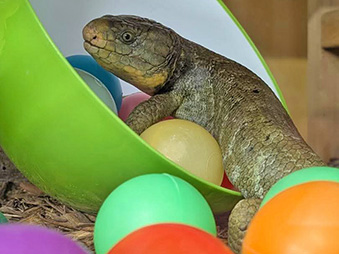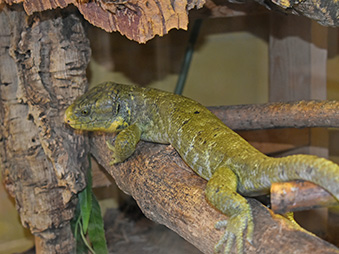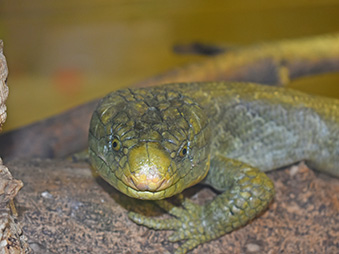Corucia zebrata | Soloman Island skink, prehensile-tailed skink, giant skink, monkey skink
Name: Pete (Male)



Meet Pete, the Prehensile-Tailed Skink
Also known as the Solomon Island Skink or Monkey Skink, the Prehensile-Tailed Skink is a large, slow-moving lizard native to the tropical rainforests of the Solomon Islands. These herbivorous reptiles are arboreal, meaning they spend most of their lives high in the forest canopy. Their strong, grasping tails help them navigate the treetops as they forage for leaves, flowers, and fruit.
Life in the Trees
Built for life above the forest floor, Prehensile-Tailed Skinks are expert climbers. Their long, muscular tails act almost like a fifth limb, offering stability and grip as they move among the branches. Sharp, hooked claws allow them to cling securely to bark and foliage, while their broad, chisel-like teeth are perfectly adapted for cutting through tough, fibrous plants—a necessity for their strictly plant-based diet.
Skinks like Pete are crepuscular, meaning they are most active during dawn and dusk. During the heat of the day, they retreat to tree hollows or hide behind dense foliage for protection and rest.
Unlike many reptiles, Prehensile-Tailed Skinks are social creatures. They often live in small family groups called circulus, which may include both related and unrelated individuals. This rare social structure among reptiles highlights just how unique and adaptable these skinks are in their complex rainforest environment.
Remarkable Reptilian Traits
One of the most fascinating things about the Prehensile-Tailed Skink is its method of reproduction. Unlike most reptiles that lay eggs, these skinks are ovoviviparous—they retain eggs internally and give birth to live young. Newborn skinks are surprisingly large, typically one-third the size of their mother, and both parents may help protect them for several months after birth.
Despite their slow pace, Prehensile-Tailed Skinks are well-equipped to avoid predators. Their greenish-brown coloration blends seamlessly with their leafy surroundings, and by remaining still, they can be nearly invisible in the dense canopy.
Not-a-Pet
Though Pete is an amazing animal to observe and learn about, Prehensile-Tailed Skinks are not suitable pets for most people. They require large, vertically oriented enclosures with specialized lighting, a strict herbivorous diet, and access to veterinary care from reptile experts. Adults can reach lengths of up to 2.5 feet, and their arboreal nature means they need room to climb and explore.
Unfortunately, many skinks like Pete end up in rescue situations when people realize too late how much care and commitment they require. That’s why it’s best to appreciate these reptiles in zoos, aquariums, or through educational resources. To learn more about why reptiles often aren’t good pets, visit the Not-a-Pet campaign.
Fact Sheet
Taxonomy
Species: Corucia zebrata
Kingdom: Animalia | Phylum: Chordata | Class: Reptilia | Order: Sqamata | Family: Scincidae | Genus: Corucia |
Favorite Enrichment Type
Ball pits, toys floating in his pool, things to climb on (such as new plants, antlers, branches, large toys), different textures (such as daisy mats and butcher paper), and pretzel jars.
Life Span
- In the Wild: 15 to 20 years
- In Human Care: Up to 25 years
Diet
- In the Wild: Leaves, flowers, fruit, and shoots.
- At the Zoo: Leafy greens and occasional fruits, vegetables, hard-boiled egg whites, and vitamin supplements.
Geographic Range
Papua New Guinea (North Solomons); Solomon Islands.
Habitat
The upper canopy of tropical rainforests.
Fun Facts
- Social by Nature: Unlike most reptiles, these skinks live in small, family-based groups called circulus.
- Live Birth: Females give birth to one or two fully formed young after a 6–8 month gestation period.
- Masters of Disguise: Their green-brown color and stillness help them disappear into the canopy, avoiding predators.
- Leaf-Eaters Extraordinaire: Chisel-like teeth make it easy for them to munch on tough, fibrous plants.
- Tail with a Purpose: Their prehensile tails act like a fifth limb, allowing them to grip branches and move confidently through the treetops.
Status: Near Threatened
Conservation Concerns
Prehensile-Tailed Skinks are currently listed as Near Threatened, largely due to habitat loss and the illegal pet trade. These ongoing threats continue to impact wild populations. By learning about and supporting conservation efforts, we can help protect these incredible creatures and their rainforest homes for generations to come.
How to Find Me
Pete is a member of our Ambassador Animals that live behind the scenes! If you would like to meet Pete in person, check out our daily, 11:00am Amphitheater Presentations at the Awareness Amphitheater, located just beyond the covered bridge. Amphitheater Presentations are dependent on the weather. Please check our activity board, behind the Admissions booth, before coming to see us!
